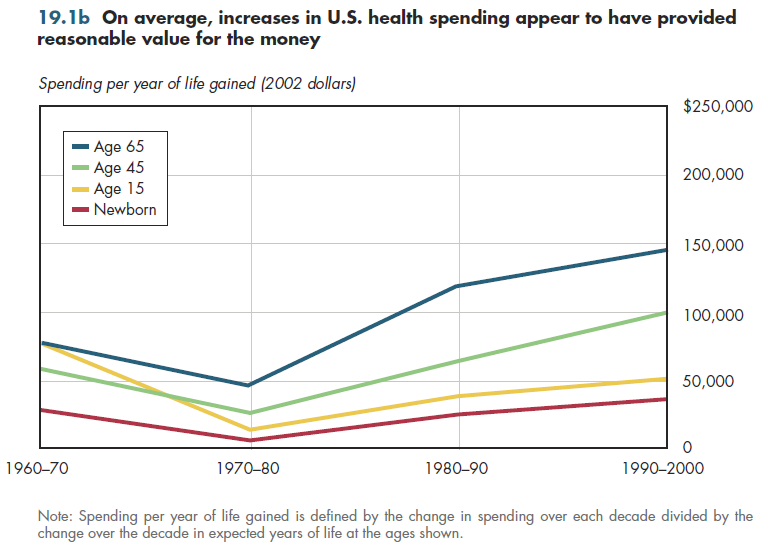Download PowerPoint versions of both figures.
Inside Collection (Book): American Health Economy Illustrated
19.1 US Health Spending Appears to Provide Good Value for the Money
Summary: Health spending in recent decades appears to have been "worth it" on average, but this likely masks much wasted spending.
The United States appears to have attained good value for the money from the trillions of dollars spent on health care since 1987 (figure 19.1a). The average cost-effectiveness of this sizable expenditure is only approximate because certainty about how much of the gain in life expectancy over this period can be attributed to medical care is not achievable.

Studies of individual factors (for example, infant mortality and mortality due to heart problems) suggest that medical care improvements have been responsible for at least half of the observed mortality reductions during this time. Thus, the numbers in figure 19.1a result from an assumption that half of life expectancy gains are from expenditures on medical care, as opposed to investments in highway safety, changes in drunk driving laws, speed limits, and other non-medical factors that surely also made a contribution.
Even precisely specifying the exact contribution of health spending to better health, some might disagree about what threshold to use to distinguish spending that was cost-effective from that which was not. Medicare spends approximately $75,000 a year on kidney dialysis for each patient who has end-stage renal disease. Without it, such patients would die. Thus, a minimum estimate of the value of life in the United States (implied by our willingness to pay for it) is $75,000 per year. As figure 19.1a shows, spending for all age categories was less than this threshold. Thus, on average, we apparently received good value for the money from health spending.
However, not all added years of life are lived in good health (for example, added years for someone who is bedridden). A quality-adjusted life-year (QALY) is one in good health, that is, two years in bed might be viewed as one QALY. For the elderly, spending per added QALY was more than $130,000. Reasonable people can disagree about whether such spending was worthwhile.
A somewhat less-detailed analysis has examined health spending since 1960. This too shows mixed results. Spending per added year of life generally was less than the $75,000 threshold for most ages and times (figure 19.1b). Again, this suggests that health spending provided good value for the money on average, but the cost to achieve an added year of life appears to be increasing. Even being cost-effective on average does not mean that there is no waste or inefficiency in how we spend health dollars.

Downloads
References
- Cutler DM. A Health Report Card for the Nation. ASHE Presentation. June 6, 2006. http://healtheconomics.us/conference/2006/plenaries/powerpoint/cutler- madison.ppt (accessed August 18, 2010).
- Cutler DM, A Rosen and S Vijan. The Value of Medical Spending in the United States, 1960-2000. The New England Journal of Medicine 2006; 355(9):920-28.
Collection Navigation
- « Previous module in collection 18.3 US Accounts for a Relatively Small Share of Pharmaceutical Exports
- Collection home: American Health Economy Illustrated
- Next module in collection » 19.2 Geographic Differences in Broad Health Outcomes Are Associated with Health Spending
Content actions
Give feedback:
Download:
Add:
Reuse / Edit:
Twin Cities Campus:
- © 2012 Regents of the University of Minnesota. All rights reserved.
- The University of Minnesota is an equal opportunity educator and employer. Privacy
- Last modified on Sep 24, 2013 3:19 pm -0500









